Assessment of Soil Erosion Risk in Cultural Heritage Sites: A Bibliometric Analysis
Abstract
1. Introduction
2. Remote Sensing Technologies for Soil Erosion Estimation
2.1. Optical Remote Sensing
2.2. Synthetic Aperture Radar (SAR)
2.3. Unmanned Aerial Vehicles (UAVs)
2.4. Remote Sensing Products
3. Materials and Methods
3.1. Data Source Selection and Search Strategy
3.2. Data Screening, Analysis, and Visualization Strategy
4. Results
4.1. Spatial and Temporal Distribution of Published Studies
4.2. Co-Occurrence of Authors’ Keywords
4.3. Country Co-Authorship Network
4.4. Thematic Map
5. Discussion
5.1. Methodologies
5.2. Applications Based on Remote Sensing for Soil Erosion Study in Cultural Heritage Sites
5.3. Challenges and Opportunities
6. Conclusions
- (1)
- From 1994 to 2014, the annual number of publications was small, with only one or no publications each year. Since 2016, there was a slight increase, showing relative stability in the number of publications. This trend may be attributed to significant advancements in remote sensing, data accessibility, and processing techniques.
- (2)
- The majority of articles focused on cultural heritage sites in the Mediterranean region, which are more susceptible to soil erosion hazards induced by extreme weather events due to complex topography and heterogeneous environment with steep slope areas accounting for 31.7% of the total publications.
- (3)
- Optical data, such as open access multi-temporal Landsat (TM, ETM+, and OLI) and Sentinel 2 A/B (MSI) are mainly implemented in the reviewed studies for soil erosion observations. UAV data is applied in a significant number of papers. Additionally, few studies employed more than one sensor for estimating soil erosion to improve spatial or temporal coverage continuity and overall accuracy.
- (4)
- A wide array of remote sensing-based approaches for quantitative assessment are suggested in the literature, such as soil erosion models and spectral indices. These approaches combined with spatial datasets have been effectively employed for understanding soil erosion conditions and the regulatory mechanisms of soil erosion vulnerability. Notably, soil erosion models integrating with terrain, satellite, and precipitation data have become essential in remote sensing-based soil management research for calculating soil erosion rates and determining main triggering factors of soil degradation. Spectral indices such as NDVI were the primarily utilized indicator to study vegetation conditions.
Author Contributions
Funding
Data Availability Statement
Acknowledgments
Conflicts of Interest
References
- European Commission (EC). Proposal for a Directive of the European Parliament and of the Council Establishing a Framework for the Protection of Soil and Amending Directive 2004/35/ec (com (2006)232). 2006. Available online: http://eur-lex.europa.eu/legal-content/EN/TXT/?uri=CELEX%3A52006PC0232 (accessed on 7 March 2025).
- Li, Z.; Fang, H. Impacts of climate change on water erosion: A review. Earth-Sci. Rev. 2016, 163, 94–117. [Google Scholar] [CrossRef]
- Borrelli, P.; Robinson, D.A.; Panagos, P.; Ballabio, C. Land use and climate change impacts on global soil erosion by water (2015–2070). Proc. Natl. Acad. Sci. USA 2020, 117, 21994–22001. [Google Scholar] [CrossRef]
- Pimentel, D.; Harvey, C.; Resosudarmo, P.; Sinclair, K.; Kurz, D.; McNair, M.; Crist, S.; Sphpritz, L.; Fitton, L.; Saffouri, R.; et al. Environmental and economic costs of soil erosion and conservation benefits. Science 1995, 267, 1117–1123. [Google Scholar] [CrossRef]
- Tamene, L.; Park, S.J.; Dikau, R.; Vlek, P.L.G. Analysis of factors determining sediment yield variability in the highlands of northern Ethiopia. Geomorphology 2006, 76, 76–91. [Google Scholar] [CrossRef]
- Blanco, H.; Lal, R. Principles of Soil Conservation and Management; Springer: New York, NY, USA, 2008; pp. 167–169. [Google Scholar]
- Ali, M.G.; Ali, S.; Arshad, R.H.; Nazeer, A.; Waqas, M.M.; Waseem, M.; Aslam, R.A.; Cheema, M.J.M.; Leta, M.K.; Shauket, I. Estimation of Potential Soil Erosion and Sediment Yield: A Case Study of the Transboundary Chenab River Catchment. Water 2021, 13, 3647. [Google Scholar] [CrossRef]
- Islam, F.; Ahmad, M.N.; Janjuhah, H.T.; Ullah, M.; Islam, I.U.; Kontakiotis, G.; Skilodimou, H.D.; Bathrellos, G.D. Modelling and Mapping of Soil Erosion Susceptibility of Murree, Sub-Himalayas Using GIS and RS-Based Models. Appl. Sci. 2022, 12, 12211. [Google Scholar] [CrossRef]
- Carollo, F.G.; Nicosia, A.; Palmeri, V.; Pampalone, V.; Serio, M.A.; Ferro, V. Measuring Rainfall Kinetic Power in Two Sicilian Experimental Areas by Drop-Size Distribution Data. Land 2023, 12, 418. [Google Scholar] [CrossRef]
- Bryan, R.B.; Campell, J. Runoff and sediment discharge in a semiarid ephemeral drainage basin. Z. Für Geomorphol. Suppl. 1986, 58, 121–143. [Google Scholar]
- Mitchell, D.J. The use of vegetation and land use parameters in modelling catchment sediment yields. In Vegetation and Erosion: Processes and Environments; Thomes, J.B., Ed.; Wiley: Chichester, UK, 1990; pp. 289–314. [Google Scholar]
- Zachar, D. Soil Erosion; Cowan, M., Ed.; Elsevier Scientific Pub. Co.: New York, NY, USA, 1982; Available online: https://scholar.google.com/scholar?hl=en&as_sdt=0%2C5&q=12.%09Zachar%2C+D.+Soil+Erosion%3B+Cowan%2C+M.%2C+Ed.%3B+Elsevier+Scientific+Pub.+Co.%3A+New+York%2C+NY%2C+USA%2C+1982.&btnG= (accessed on 7 March 2025).
- Kinnell, P.I.A. Raindrop impact—Induced erosion processes and prediction—A review. Hydrol. Process 2005, 19, 2815–2844. [Google Scholar] [CrossRef]
- Nearing, M.A.; Pruski, F.F.; O’neal, M.R. Expected climate change impacts on soil erosion rates: A review. J. Soil Water Conserv. 2004, 59, 43–50. [Google Scholar] [CrossRef]
- Morgan, R.P.C. Soil Erosion and Conservation, 3rd ed.; Blackwell Publishing Ltd.: Malden, MA, USA, 2005. [Google Scholar] [CrossRef]
- Gong, W.; Liu, T.; Duan, X.; Sun, Y.; Zhang, Y.; Tong, X.; Qiu, Z. Estimating the Soil Erosion Response to Land-Use Land-Cover Change Using GIS-Based RUSLE and Remote Sensing: A Case Study of Miyun Reservoir, North China. Water 2022, 14, 742. [Google Scholar] [CrossRef]
- Borrelli, P.; Robinson, D.A.; Fleischer, L.R.; Lugato, E.; Ballabio, C.; Alewell, C.; Meusburger, K.; Modugno, S.; Schütt, B.; Ferro, V.; et al. An assessment of the global impact of 21st century land use change on soil erosion. Nat. Commun. 2017, 8, 2013. [Google Scholar] [CrossRef] [PubMed]
- Camacho-Zorogastúa, K.d.C.; Cesar Minga, J.; Gómez-Lora, J.W.; Gallo-Ramos, V.H.; Garcés Díaz, V. Evaluation of Soil Loss and Sediment Yield Based on GIS and Remote Sensing Techniques in a Complex Amazon Mountain Basin of Peru: Case Study Mayo River Basin, San Martin Region. Sustainability 2023, 15, 9059. [Google Scholar] [CrossRef]
- Xiong, M.; Guoyong, L. Global soil water erosion responses to climate and land use changes. Catena 2024, 241, 108043. [Google Scholar] [CrossRef]
- Agapiou, A.; Lysandrou, V.; Hadjimitsis, D.G. A European-Scale Investigation of Soil Erosion Threat to Subsurface Archaeological Remains. Remote Sens. 2020, 12, 675. [Google Scholar] [CrossRef]
- Pederson, J.L.; Petersen, P.A.; Dierker, J.L. Gullying and erosion control at archaeological sites in Grand Canyon, Arizona. Earth Surf. Proc. Landf. 2006, 31, 507–525. [Google Scholar] [CrossRef]
- Robinson, M.H.; Alexander, C.R.; Jackson, C.W.; McCabe, C.P.; Crass, D. Threatened archaeological, historic, and cultural resources of the Georgia Coast: Identification, prioritization and management using GIS technology. Geoarchaeology 2010, 25, 312–326. [Google Scholar] [CrossRef]
- Meylemans, E.; Poesen, J.; In’t Ven, I. The Archaeology of Erosion, the Erosion of Archaeology: Proceedings of the Brussels Conference, April 28–30, 2008; Flanders Heritage Agency: Brussels, Belgium, 2017. [Google Scholar] [CrossRef]
- Wilkinson, K.; Tyler, A.; Davidson, D.; Grieve, I. Quantifying the threat to archaeological sites from the erosion of cultivated soil. Antiquity 2006, 80, 658–670. [Google Scholar] [CrossRef]
- Bell, M.; Boardman, J. Past and Present Soil Erosion (Oxbow Monograph); Oxbow Books: Oxford, UK, 1992; Available online: https://scholar.google.com/scholar?hl=en&as_sdt=0%2C5&q=25.%09Bell%2C+M.%3B+Boardman%2C+J.+Past+and+Present+Soil+Erosion+%28Oxbow+Monograph%29%3B+Oxbow+Books%3A+Oxford%2C+UK%2C+1992.&btnG= (accessed on 7 March 2025).
- UN. Transforming Our World: The 2030 Agenda for Sustainable Development; UN Doc. A/RES/70/1 (25 September 2015); UN: San Francisco, CA, USA, 2015. Available online: https://undocs.org/en/A/RES/70/1 (accessed on 7 March 2025).
- Porat, N.; López, G.I.; Lensky, N.; Elinson, R.; Avni, Y.; Elgart-Sharon, Y.; Faershtein, G.; Gadot, Y. Using portable OSL reader to obtain a time scale for soil accumulation and erosion in archaeological terraces, the Judean Highlands, Israel. Quat. Geochronol. 2019, 49, 65–70. [Google Scholar] [CrossRef]
- Gonnet, A.; Todisco, D.; Rasse, M.; Mouralis, D.; Lepert, T. Soil erosion and anthropogenic impact on landscape evolution over the past 2500 years: A case study of the Villers-Ecalles dry valley (Seine-Maritime, Normandy, France). Geomorphology 2023, 427, 108623. [Google Scholar] [CrossRef]
- Kappler, C.; Kaiser, K.; Tanski, P.; Klos, F.; Fülling, A.; Mrotzek, A.; Sommer, M.; Bens, O. Stratigraphy and age of colluvial deposits indicating Late Holocene soil erosion in northeastern Germany. Catena 2018, 170, 224–245. [Google Scholar] [CrossRef]
- Leopold, M.; Völkel, J. Reconstruction of the old cultural surface of a Bronze Age Settlement–An example for a multi-methodological interaction of Soil Science and Archaeology in Southern Germany. Geodin. Acta 2007, 20, 257–265. [Google Scholar] [CrossRef]
- Nicosia, A.; Carollo, F.G.; Di Stefano, C.; Palmeri, V.; Pampalone, V.; Serio, M.A.; Bagarello, V.; Ferro, V. The Importance of Measuring Soil Erosion by Water at the Field Scale: A Review. Water 2024, 16, 3427. [Google Scholar] [CrossRef]
- Xu, S.; Wang, X.; Ma, X.; Gao, S. Risk Assessment and Prediction of Soil Water Erosion on the Middle Northern Slope of Tianshan Mountain. Sustainability 2023, 15, 4826. [Google Scholar] [CrossRef]
- Valkanou, K.; Karymbalis, E.; Bathrellos, G.; Skilodimou, H.; Tsanakas, K.; Papanastassiou, D.; Gaki-Papanastassiou, K. Soil Loss Potential Assessment for Natural and Post-Fire Conditions in Evia Island, Greece. Geosciences 2022, 12, 367. [Google Scholar] [CrossRef]
- Zingaro, M.; Scicchitano, G.; Capolongo, D. The Innovative Growth of Space Archaeology: A Brief Overview of Concepts and Approaches in Detection, Monitoring, and Promotion of the Archaeological Heritage. Remote Sens. 2023, 15, 3049. [Google Scholar] [CrossRef]
- Vrieling, A. Satellite remote sensing for water erosion assessment: A review. Catena 2006, 65, 2–18. [Google Scholar] [CrossRef]
- King, C.; Baghdadi, N.; Lecomte, V.; Cerdan, O. The application of remote-sensing data to monitoring and modelling of soil erosion. Catena 2005, 2, 79–93. [Google Scholar] [CrossRef]
- Dwivedi, R.S.; Kumar, A.B.; Tewari, K.N. The utility of multisensory data for mapping eroded lands. Int. J. Remote Sens. 1997, 18, 2303–2318. [Google Scholar] [CrossRef]
- Hall, F.G.; Townshend, J.R.; Engman, E.T. Status of remote-sensing algorithms for estimation of land-surface state parameters. Remote Sens. Environ. 1995, 51, 138–156. [Google Scholar] [CrossRef]
- Joshi, N.; Baumann, M.; Ehammer, A.; Fensholt, R.; Grogan, K.; Hostert, P.; Jepsen, M.R.; Kuemmerle, T.; Meyfroidt, P.; Mitchard, E.T.A.; et al. A Review of the Application of Optical and Radar Remote Sensing Data Fusion to Land Use Mapping and Monitoring. Remote Sens. 2016, 8, 70. [Google Scholar] [CrossRef]
- Wang, J.; Yang, J.; Li, Z.; Ke, L.; Li, Q.; Fan, J.; Wang, X. Research on Soil Erosion Based on Remote Sensing Technology: A Review. Agriculture 2025, 15, 18. [Google Scholar] [CrossRef]
- Ji, C.; Cao, Y.; Li, X.; Pei, X.; Sun, B.; Yang, X.; Zhou, W. A review of the satellite remote sensing techniques for assessment of runoff and sediment in soil erosion. J. Hydrol. Hydromech. 2024, 72, 252–267. [Google Scholar] [CrossRef]
- Medeiros, B.M.; Cândido, B.; Jimenez, P.A.J.; Avanzi, J.C.; Silva, M.L.N. UAV-Based Soil Water Erosion Monitoring: Current Status and Trends. Drones 2025, 9, 305. [Google Scholar] [CrossRef]
- Musasa, T.; Dube, T.; Marambanyika, T. Landsat satellite programme potential for soil erosion assessment and monitoring in arid environments: A review of applications and challenges. Int. Soil Water Conserv. Res. 2023, 12, 267–278. [Google Scholar] [CrossRef]
- Epple, L.; Kaiser, A.; Schindewolf, M.; Bienert, A.; Lenz, J.; Eltner, A. A Review on the Possibilities and Challenges of Today’s Soil and Soil Surface Assessment Techniques in the Context of Process-Based Soil Erosion Models. Remote Sens. 2022, 14, 2468. [Google Scholar] [CrossRef]
- Sepuru, T.K.; Dube, T. An appraisal on the progress of remote sensing applications in soil erosion mapping and monitoring. Remote Sens. Appl. Soc. Environ. 2018, 9, 1–9. [Google Scholar] [CrossRef]
- Colwell, R.N. (Ed.) Manual of Remote Sensing, 2nd ed.; American Society for Photogrammetry and Remote Sensing: Falls Church, Virginia, 1983. [Google Scholar]
- Wulder, M.A.; White, J.C.; Loveland, T.R.; Woodcock, C.E.; Belward, A.S.; Cohen, W.B.; Fosnight, E.A.; Shaw, J.; Masek, J.G.; Roy, D.P. The global Landsat archive: Status, consolidation, and direction. Remote Sens. Environ. 2016, 185, 271–283. [Google Scholar] [CrossRef]
- Liberti, M.; Simoniello, T.; Carone, M.T.; Coppola, R.; D’Emilio, M.; Macchiato, M. Mapping badland areas using LANDSAT TM/ETM satellite imagery and morphological data. Geomorphology 2009, 106, 333–343. [Google Scholar] [CrossRef]
- Chikhaoui, M.; Bonn, F.; Bokoye, A.I.; Merzouk, A. A spectral index for land degradation mapping using ASTER data: Application to a semi-arid Mediterranean catchment. Int. J. Appl. Earth Obs. Geoinf. 2005, 7, 140–153. [Google Scholar] [CrossRef]
- El Haj El Tahir, M.; Kääb, A.; Xu, C.Y. Identification and mapping of soil erosion areas in the Blue Nile, Eastern Sudan using multispectral ASTER and MODIS satellite data and the SRTM elevation model. Hydrol. Earth. Syst. Sci. 2010, 14, 1167–1178. [Google Scholar] [CrossRef]
- Vrieling, A.; Rodrigues, S.C.; Bartholomeus, H.; Sterk, G. Automatic identification of erosion gullies with ASTER imagery in the Brazilian Cerrados. Int. J. Remote Sens. 2007, 28, 2723–2738. [Google Scholar] [CrossRef]
- Yuan, J.; Liu, X.; Li, H.; Wang, R.; Luo, X.; Xing, L.; Wang, C.; Zhao, H. Assessment of Spatial–Temporal Variations of Soil Erosion in Hulunbuir Plateau from 2000 to 2050. Land 2023, 12, 1214. [Google Scholar] [CrossRef]
- Veraverbeke, S.; Goossens, R.; Vanderstraete, T. Use of ASTER-data for a soil erosion risk model application, Chios Island (Greece). In Remote Sensing for a Changing Europe; IOS Press: Amsterdam, The Netherlands, 2009; pp. 117–124. [Google Scholar] [CrossRef]
- Abrams, M. ASTER: Data products for the high spatial resolution imager on NASA’s EOS-AM1 platform. Int. J. Remote Sens. 2000, 21, 847–861. [Google Scholar] [CrossRef]
- Vrieling, A.; de Jong, S.M.; Sterk, G.; Rodrigues, S.C. Timing of erosion and satellite data: A multi-resolution approach to soil erosion risk mapping. Int. J. Appl. Earth Obs. Geoinf. 2008, 10, 267–281. [Google Scholar] [CrossRef]
- Wohlfart, C.; Winkler, K.; Wendleder, A.; Roth, A. TerraSAR-X and Wetlands: A Review. Remote Sens. 2018, 10, 916. [Google Scholar] [CrossRef]
- Cruz, H.; Véstias, M.; Monteiro, J.; Neto, H.; Duarte, R.P. A Review of Synthetic-Aperture Radar Image Formation Algorithms and Implementations: A Computational Perspective. Remote Sens. 2022, 14, 1258. [Google Scholar] [CrossRef]
- Dabboor, M.; Olthof, I.; Mahdianpari, M.; Mohammadimanesh, F.; Shokr, M.; Brisco, B.; Homayouni, S. The Radarsat Constellation Mission Core Applications: First Results. Remote Sens. 2022, 14, 301. [Google Scholar] [CrossRef]
- Noda, A.; Suzuki, S.; Shimada, M.; Toda, K.; Miyagi, Y. COSMO-SkyMed and ALOS-1/2 X and L Band Multi-Frequency Results in Satellite Disaster Monitoring. In Proceedings of the 2015 IEEE International Geoscience and Remote Sensing Symposium (IGARSS), Milan, Italy, 26–31 July 2015; IEEE: Piscataway, NJ, USA, 2015; pp. 211–214. [Google Scholar] [CrossRef]
- Ling, M.; Chen, J.; Lan, Y.; Chen, Z.; You, H.; Han, X.; Zhou, G. Exploring the Drivers of Soil Conservation Variation in the Source of Yellow River under Diverse Development Scenarios from a Geospatial Perspective. Sustainability 2024, 16, 777. [Google Scholar] [CrossRef]
- Martínez-Graña, A.; Carrillo, J.; Lombana, L.; Criado, M.; Palacios, C. Mapping the Risk of Water Soil Erosion in Larrodrigo (Salamanca, Spain) Using the RUSLE Model and A-DInSAR Technique. Agronomy 2021, 11, 2120. [Google Scholar] [CrossRef]
- Cook, K.; Agha Karimi, A.; Grinham, A.; McDougall, K. Mapping Erosion Hotspots: Coherent Change Detection in the Quilpie Region, Queensland, Australia. Remote Sens. 2024, 16, 1263. [Google Scholar] [CrossRef]
- Jiang, C.; Fan, W.; Yu, N.; Nan, Y. A New Method to Predict Gully Head Erosion in the Loess Plateau of China Based on SBAS-InSAR. Remote Sens. 2021, 13, 421. [Google Scholar] [CrossRef]
- Lu, P.; Zhang, B.; Wang, C.; Liu, M.; Wang, X. Erosion Gully Networks Extraction Based on InSAR Refined Digital Elevation Model and Relative Elevation Algorithm—A Case Study in Huangfuchuan Basin, Northern Loess Plateau, China. Remote Sens. 2024, 16, 921. [Google Scholar] [CrossRef]
- Sánchez-Crespo, F.A.; Gómez-Villarino, M.T.; Gallego, E.; Fuentes, J.M.; García, A.I.; Ayuga, F. Monitoring of Water and Tillage Soil Erosion in Agricultural Basins, a Comparison of Measurements Acquired by Differential Interferometric Analysis of Sentinel TopSAR Images and a Terrestrial LIDAR System. Land 2023, 12, 408. [Google Scholar] [CrossRef]
- Shafique, A.; Cao, G.; Khan, Z.; Asad, M.; Aslam, M. Deep Learning-Based Change Detection in Remote Sensing Images: A Review. Remote Sens. 2022, 14, 871. [Google Scholar] [CrossRef]
- Zhang, Z.; Zhu, L. A Review on Unmanned Aerial Vehicle Remote Sensing: Platforms, Sensors, Data Processing Methods, and Applications. Drones 2023, 7, 398. [Google Scholar] [CrossRef]
- D’Oleire-Oltmanns, S.; Marzolff, I.; Peter, K.D.; Ries, J.B. Unmanned Aerial Vehicle (UAV) for Monitoring Soil Erosion in Morocco. Remote Sens. 2012, 4, 3390–3416. [Google Scholar] [CrossRef]
- Mirzaee, S.; Gomez, C.; Pajouhesh, M.; Abdollahi, K. Soil erosion and sediment change detection using UAV technology. In Remote Sensing of Soil and Land Surface Processes; Elsevier: Amsterdam, The Netherlands, 2024; pp. 271–279. [Google Scholar] [CrossRef]
- Alexiou, S.; Papanikolaou, I.; Schneiderwind, S.; Kehrle, V.; Reicherter, K. Monitoring and Quantifying Soil Erosion and Sedimentation Rates in Centimeter Accuracy Using UAV-Photogrammetry, GNSS, and t-LiDAR in a Post-Fire Setting. Remote Sens. 2024, 16, 802. [Google Scholar] [CrossRef]
- Moore, I.D.; Grayson, R.B.; Ladson, A.R. Digital Terrain Modelling: A Review of Hydrological, Geomorphological, and Biological Applications. Hydrol. Process. 1991, 5, 3–30. [Google Scholar] [CrossRef]
- Liu, Q.Q.; Chen, L.; Li, J.C. Influences of Slope Gradient on Soil Erosion. Appl. Math. Mech. 2001, 22, 510–519. [Google Scholar] [CrossRef]
- Buitrago, J.Y.; Martínez, L.J. Digital elevation models (DEM) used to assess soil erosion risks: A case study in Boyaca, Colombia. Agron. Colomb. 2016, 34, 239–249. [Google Scholar] [CrossRef]
- Mizukoshi, H.; Masamu, A. Use of contour-based DEMs for deriving and mapping topographic attributes. Photogramm. Eng. Remote Sens. 2002, 68, 83–93. [Google Scholar]
- Toutin, T. Elevation modelling from satellite visible and infrared (VIR) data. Int. J. Remote Sens. 2001, 22, 1097–1125. [Google Scholar] [CrossRef]
- Toutin, T.; Gray, L. State-of-the-art of elevation extraction from satellite SAR data. ISPRS J. Photogramm. Remote Sens. 2000, 55, 13–33. [Google Scholar] [CrossRef]
- Mondal, A.; Khare, D.; Kundu, S.; Mukherjee, S.; Mukhopadhyay, A.; Mondal, S. Uncertainty of Soil Erosion Modelling Using Open Source High Resolution and Aggregated DEMs. Geosci. Front. 2017, 8, 425–436. [Google Scholar] [CrossRef]
- Michalopoulou, M.; Depountis, N.; Nikolakopoulos, K.; Boumpoulis, V. The Significance of Digital Elevation Models in the Calculation of LS Factor and Soil Erosion. Land 2022, 11, 1592. [Google Scholar] [CrossRef]
- Ren, S.; Liang, Y.; Sun, B. Research on sensitivity for soil erosion evaluation from DEM and remote sensing data source of different map scales and image resolutions. Procedia Environ. Sci. 2011, 10, 1753–1760. [Google Scholar] [CrossRef]
- Datta, P.S.; Schack-Kirchner, H. Erosion Relevant Topographical Parameters Derived from Different DEMs—A Comparative Study from the Indian Lesser Himalayas. Remote Sens. 2010, 2, 1941–1961. [Google Scholar] [CrossRef]
- Micić Ponjiger, T.; Lukić, T.; Basarin, B.; Jokić, M.; Wilby, R.L.; Pavić, D.; Mesaroš, M.; Valjarević, A.; Milanović, M.M.; Morar, C. Detailed Analysis of Spatial–Temporal Variability of Rainfall Erosivity and Erosivity Density in the Central and Southern Pannonian Basin. Sustainability 2021, 13, 13355. [Google Scholar] [CrossRef]
- Thomas, J.; Prasannakumar, V.; Vineetha, P. Suitability of space-borne digital elevation models of different scales in topographic analysis: An example from Kerala, India. Environ. Earth Sci. 2015, 73, 1245–1263. [Google Scholar] [CrossRef]
- Stokstad, E. Hydrology—Scarcity of rain, stream gages threatens forecasts. Science 1999, 285, 1199–1200. [Google Scholar] [CrossRef]
- De Santos Loureiro, N.; de Azevedo Coutinho, M. A new procedure to estimate the RUSLE EI30 Index, based on monthly rainfall data and applied to the Algarve region, Portugal. J. Hydrol. 2001, 250, 12–18. [Google Scholar] [CrossRef]
- Stisen, S.; Sandholt, I. Evaluation of remote-sensing-based rainfall products through predictive capability in hydrological runoff modelling. Hydrol. Process 2010, 24, 879–891. [Google Scholar] [CrossRef]
- Kummerow, C.; Barnes, W.; Kozu, T.; Shiue, J.; Simpson, J. The Tropical Rainfall Measuring Mission (TRMM) sensor package. J. Atmos. Ocean. Technol. 1998, 15, 809–817. [Google Scholar] [CrossRef]
- Hsu, K.-L.; Gao, X.; Sorooshian, S.; Gupta, H.V. Precipitation estimation from remotely sensed information using artificial neural networks. J. Appl. Meteorol. Climatol. 1997, 36, 1176–1190. [Google Scholar] [CrossRef]
- Sorooshian, S.; Hsu, K.-L.; Gao, X.; Gupta, H.V.; Imam, B.; Braithwaite, D. Evaluation of PERSIANN system satellite-based estimates of tropical rainfall. Bull. Am. Meteorol. Soc. 2000, 81, 2035–2046. [Google Scholar] [CrossRef]
- Hou, A.Y.; Kakar, R.K.; Neeck, S.; Azarbarzin, A.A.; Kummerow, C.D.; Kojima, M.; Oki, R.; Nakamura, K.; Iguchi, T. The global precipitation measurement mission. Bull. Am. Meteorol. Soc. 2014, 95, 701–722. [Google Scholar] [CrossRef]
- Yonaba, R.; Mounirou, L.A.; Keïta, A.; Fowé, T.; Zouré, C.O.; Belemtougri, A.; Kafando, M.B.; Koïta, M.; Karambiri, H.; Yacouba, H. Exploring the Added Value of Sub-Daily Bias Correction of High-Resolution Gridded Rainfall Datasets for Rainfall Erosivity Estimation. Hydrology 2024, 11, 132. [Google Scholar] [CrossRef]
- Emberson, R.A. Dynamic rainfall erosivity estimates derived from IMERG data. Hydrol. Earth Syst. Sci. 2023, 27, 3547–3563. [Google Scholar] [CrossRef]
- Wang, W.; Jiang, Y.; Yu, B.; Zhang, X.; Xie, Y.; Yin, B. Evaluation of GPM IMERG-FR Product for Computing Rainfall Erosivity for Mainland China. Remote Sens. 2024, 16, 1186. [Google Scholar] [CrossRef]
- Serbaji, M.M.; Bouaziz, M.; Weslati, O. Soil Water Erosion Modeling in Tunisia Using RUSLE and GIS Integrated Approaches and Geospatial Data. Land 2023, 12, 548. [Google Scholar] [CrossRef]
- Li, X.; Ye, X.; Xu, C. Assessment of Satellite-Based Precipitation Products for Estimating and Mapping Rainfall Erosivity in a Subtropical Basin, China. Remote Sens. 2022, 14, 4292. [Google Scholar] [CrossRef]
- Li, X.; Li, Z.; Lin, Y. Suitability of TRMM Products with Different Temporal Resolution (3-Hourly, Daily, and Monthly) for Rainfall Erosivity Estimation. Remote Sens. 2020, 12, 3924. [Google Scholar] [CrossRef]
- Teng, H.; Ma, Z.; Chappell, A.; Shi, Z.; Liang, Z.; Yu, W. Improving Rainfall Erosivity Estimates Using Merged TRMM and Gauge Data. Remote Sens. 2017, 9, 1134. [Google Scholar] [CrossRef]
- Delgado, D.; Sadaoui, M.; Ludwig, W.; Méndez, W. Spatio-temporal assessment of rainfall erosivity in Ecuador based on RUSLE using satellite-based high frequency GPM-IMERG precipitation data. Catena 2022, 219, 106597. [Google Scholar] [CrossRef]
- Zhu, Q.; Chen, X.W.; Fan, Q.X.; Jin, H.P.; Li, J.R. A new procedure to estimate the rainfall erosivity factor based on Tropical Rainfall Measuring Mission (TRMM) data. Sci. China Technol. Sci. 2011, 54, 2437–2445. [Google Scholar] [CrossRef]
- Guo, J.; Chen, J.; Qi, S. Impact of Land Use/Cover Change on Soil Erosion and Future Simulations in Hainan Island, China. Water 2024, 16, 2654. [Google Scholar] [CrossRef]
- Gyssels, G.; Poesen, J.; Bochet, E.; Li, Y. Impact of plant roots on the resistance of soils to erosion by water: A review. Prog. Phys. Geogr. 2005, 29, 189–217. [Google Scholar] [CrossRef]
- Mamo, A.T.; Wedajo, G.K. Responses of soil erosion and sediment yield to land use/land cover changes: In the case of Fincha’a watershed, upper Blue Nile Basin, Ethiopia. Environ. Chall. 2023, 13, 100789. [Google Scholar] [CrossRef]
- Zhu, M. Soil erosion risk assessment with CORINE model: Case study in the Danjiangkou Reservoir region, China. Stoch. Environ. Res. Risk Assess. 2012, 26, 813–822. [Google Scholar] [CrossRef]
- Chen, G.; Zhao, J.; Duan, X.; Tang, B.; Zuo, L.; Wang, X.; Guo, Q. Spatial Quantification of Cropland Soil Erosion Dynamics in the Yunnan Plateau Based on Sampling Survey and Multi-Source LUCC Data. Remote Sens. 2024, 16, 977. [Google Scholar] [CrossRef]
- Fang, H.; Fan, Z. Assessment of Soil Erosion at Multiple Spatial Scales Following Land Use Changes in 1980–2017 in the Black Soil Region, (NE) China. Int. J. Environ. Res. Public Health 2020, 17, 7378. [Google Scholar] [CrossRef]
- Lin, S.; Zou, Y.; He, Y.; Xue, S.; Zhu, L.; Ye, C. A Spatiotemporal Dynamic Evaluation of Soil Erosion at a Monthly Scale and the Identification of Driving Factors in Hainan Island Based on the Chinese Soil Loss Equation Model. Sustainability 2025, 17, 2361. [Google Scholar] [CrossRef]
- Wang, S.; Xu, X.; Huang, L. Spatial and Temporal Variability of Soil Erosion in Northeast China from 2000 to 2020. Remote Sens. 2023, 15, 225. [Google Scholar] [CrossRef]
- Busico, G.; Grilli, E.; Carvalho, S.C.P.; Mastrocicco, M.; Castaldi, S. Assessing Soil Erosion Susceptibility for Past and Future Scenarios in Semiarid Mediterranean Agroecosystems. Sustainability 2023, 15, 12992. [Google Scholar] [CrossRef]
- Panagos, P.; Ballabio, C.; Poesen, J.; Lugato, E.; Scarpa, S.; Montanarella, L.; Borrelli, P. A Soil Erosion Indicator for Supporting Agricultural, Environmental and Climate Policies in the European Union. Remote Sens. 2020, 12, 1365. [Google Scholar] [CrossRef]
- Stefanidis, S.; Mallinis, G.; Alexandridis, V. Multi-Decadal Monitoring of Soil Erosion Rates in South Europe. Environ. Sci. Proc. 2023, 26, 138. [Google Scholar] [CrossRef]
- Sestras, P.; Mircea, S.; Cîmpeanu, S.M.; Teodorescu, R.; Roșca, S.; Bilașco, Ș.; Rusu, T.; Salagean, T.; Dragomir, L.O.; Marković, R.; et al. Soil Erosion Assessment Using the Intensity of Erosion and Outflow Model by Estimating Sediment Yield: Case Study in River Basins with Different Characteristics from Cluj County, Romania. Appl. Sci. 2023, 13, 9481. [Google Scholar] [CrossRef]
- Panagos, P.; Karydas, C.; Borrelli, P.; Ballabio, C.; Meusburger, K. Advances in soil erosion modelling through remote sensing data availability at European scale. In Proceedings of the Second International Conference on Remote Sensing and Geoinformation of the Environment (RSCy2014), Paphos, Cyprus, 7–10 April 2014. [Google Scholar] [CrossRef]
- Chen, J.; Chen, J.; Liao, A.; Cao, X.; Chen, L.; Chen, X.; He, C.; Han, G.; Peng, S.; Lu, M. Global land cover mapping at 30m resolution: A pok-based operational approach. ISPRS J. Photogramm. Remote Sens. 2015, 103, 7–27. [Google Scholar] [CrossRef]
- Friedl, M.A.; McIver, D.K.; Hodges, J.C.F.; Zhang, X.Y.; Muchoney, D.; Strahler, A.H.; Woodcock, C.E.; Gopal, S.; Schneider, A.; Cooper, A.; et al. Global land cover mapping from MODIS: Algorithms and early results. Remote Sens. Environ. 2002, 83, 287–302. [Google Scholar] [CrossRef]
- Bontemps, S.; Defournya, P.; Van Bogaert, E.; Weber, J.L.; Arino, O. GlobCorine—A joint EEA-ESA project for operational land dynamics monitoring at pan-European scale. In Proceedings of the 33rd International Symposium on Remote Sensing of Environment, Stresa, Italy, 4–8 May 2009. [Google Scholar]
- Zanaga, D.; Van De Kerchove, R.; Daems, D.; De Keersmaecker, W.; Brockmann, C.; Kirches, G.; Wevers, J.; Cartus, O.; Santoro, M.; Fritz, S.; et al. ESA WorldCover 10 m 2020 v100. Zenodo. Available online: https://zenodo.org/records/5571936 (accessed on 7 March 2025).
- Karra, K.; Kontgis, C.; Statman-Weil, Z.; Mazzariello, J.C.; Mathis, M.; Brumby, S.P. Global Land Use/Land Cover with Sentinel 2 and Deep Learning; IEEE: Manhattan, NY, USA, 2021; pp. 4704–4707. [Google Scholar] [CrossRef]
- Liu, P.; Pei, J.; Guo, H.; Tian, H.; Fang, H.; Wang, L. Evaluating the Accuracy and Spatial Agreement of Five Global Land Cover Datasets in the Ecologically Vulnerable South China Karst. Remote Sens. 2022, 14, 3090. [Google Scholar] [CrossRef]
- Nearing, M.A.; Govers, G.; Norton, L.D. Variability in Soil Erosion Data from Replicated Plots. Soil Sci. Soc. Am. J. 1999, 63, 1829–1835. [Google Scholar] [CrossRef]
- Loughran, R.J. The measurement of soil erosion. Prog. Phys. Geogr. 1989, 13, 216–233. [Google Scholar] [CrossRef]
- Hudson, N.W. Field measurement of soil erosion and runoff. In FAO Soils Bulletin; Food & Agriculture Organization: Rome, Italy, 1983; p. 139. Available online: https://www.fao.org/4/t0848e/t0848e00.htm (accessed on 27 March 2025).
- Boix-Fayos, C.; Martínez-Mena, M.; Arnau-Rosalén, E.; Calvo-Cases, A.; Castillo, V.; Albaladejo, J. Measuring soil erosion by field plots: Understanding the sources of variation. Earth-Sci. Rev. 2006, 78, 267–285. [Google Scholar] [CrossRef]
- Stroosnijder, L. Measurement of erosion: Is it possible? CATENA 2005, 64, 162–173. [Google Scholar] [CrossRef]
- Renard, K.G.; Foster, G.R.; Weesies, G.A.; Porter, J.P. RUSLE: Revised universal soil loss equation. J. Soil Water Conserv. 1991, 46, 30–33. [Google Scholar] [CrossRef]
- Mitasova, H.; Hofierka, J.; Zlocha, M.; Iverson, L.R. Modelling topographic potential for erosion and deposition using GIS. Int. J. Geogr. Inf. Syst. 1996, 10, 629–641. [Google Scholar] [CrossRef]
- Phinzi, K.; Ngetar, N.S. The Assessment of Water-Borne Erosion at Catchment Level Using GIS-Based RUSLE and Remote Sensing: A Review. Int. Soil Water Conserv. Res. 2019, 7, 27–46. [Google Scholar] [CrossRef]
- Karaburun, A. Estimation of C factor for soil erosion modeling using NDVI in Buyukcekmece watershed. Ozean J. Appl. Sci. 2010, 3, 77–85. [Google Scholar]
- Ye, S.; Pontius, R.G.; Rakshit, R. A Review of Accuracy Assessment for Object-Based Image Analysis: From Per-Pixel to Per-Polygon Approaches. ISPRS J. Photogramm. Remote Sens. 2018, 141, 137–147. [Google Scholar] [CrossRef]
- Nogueira, K.; Machado, G.L.S.; Gama, P.H.T.; da Silva, C.C.V.; Balaniuk, R.; dos Santos, J.A. Facing Erosion Identification in Railway Lines Using Pixel-Wise Deep-Based Approaches. Remote Sens. 2020, 12, 739. [Google Scholar] [CrossRef]
- Apostolou, G.; Venieri, K.; Mayoral, A.; Dimaki, S.; Garcia-Molsosa, A.; Georgiadis, M.; Orengo, H.A. Long-Term Settlement Dynamics in Ancient Macedonia: A New Multi-Disciplinary Survey from Grevena (NW Greece). Land 2024, 13, 1769. [Google Scholar] [CrossRef]
- Papageorgiou, N.; Hadjimitsis, D.G. Evaluation of Soil Loss by Water in Archaeological Landscapes by Using the (R)USLE Model and GIS. The Case Study of Paphos District, Cyprus. In Digital Heritage. Progress in Cultural Heritage: Documentation, Preservation, and Protection; Ioannides, M., Fink, E., Cantoni, L., Champion, E., Eds.; EuroMed 2020; Lecture Notes in Computer Science 2020; Springer: Cham, Switzerland, 2021; Volume 12642. [Google Scholar] [CrossRef]
- Agapiou, A.; Lysandrou, V.; Themistocleous, K.; Hadjimitsis, D.G. Risk assessment of cultural heritage sites clusters using satellite imagery and GIS: The case study of Paphos District, Cyprus. Nat. Hazards 2016, 83 (Suppl. S1), 5–20. [Google Scholar] [CrossRef]
- Cuca, B.; Tzouvaras, M.; Agapiou, A.; Lysandrou, V.; Themistocleous, K.; Nisantzi, A.; Hadjimitsis, D.G. Earth observation technologies in service to the cultural landscape of Cyprus: Risk identification and assessment. In Proceedings of the Fourth International Conference on Remote Sensing and Geoinformation of the Environment (RSCy2016), Paphos, Cyprus, 4–8 April 2016; Themistocleous, K., Hadjimitsis, D.G., Michaelides, S., Papadavid, G., Eds.; SPIE: Bellingham, WA, USA, 2016; Volume 9688, p. 96880Y-1. [Google Scholar] [CrossRef]
- Michaelides, K.; Hadjipetrou, S.; Agapiou, A.; Sarris, A.; Klinkenberg, V.; Polidorou, M. Addressing Cultural Heritage Challenges: Applications of Open-Access Remote Sensing Datasets for Monitoring Threats. Int. Arch. Photogramm. Remote Sens. Spatial Inf. Sci. 2025, XLVIII-M-7-2025, 67–74. [Google Scholar] [CrossRef]
- Fall, P.L.; Falconer, S.E.; Galletti, C.S.; Shirmang, T.; Ridder, E.; Klinge, J. Long-term agrarian landscapes in the Troodos 1015 foothills, Cyprus. J. Archaeol. Sci. 2012, 39, 2335–2347. [Google Scholar] [CrossRef]
- Gabriele, M.; Brumana, R.; Previtali, M.; Cazzani, A. A combined GIS and remote sensing approach for monitoring climate change-related land degradation to support landscape preservation and planning tools: The Basilicata case study. Appl. Geomat. 2022, 26, 497–532. [Google Scholar] [CrossRef]
- Kincey, M.; Batty, L.; Chapman, H.; Gearey, B.; Ainsworth, S.; Challis, K. Assessing the changing condition of industrial archaeological remains on Alston Moor, UK, using multisensor remote sensing. J. Archaeol. Sci. 2014, 45, 36–51. [Google Scholar] [CrossRef]
- Lombardo, L.; Tanyas, H.; Nicu, C.I. Spatial modeling of multi-hazard threat to cultural heritage sites. Eng. Geol. 2020, 277, 105776. [Google Scholar] [CrossRef]
- Agapiou, A.; Lysandrou, V.; Alexakis, D.D.; Themistocleous, K.; Cuca, B.; Argyriou, A.; Sarris, A.; Hadjimitsis, D.G. Cultural heritage management and monitoring using remote sensing data and GIS: The case study of Paphos area, Cyprus. Comput. Environ. Urban Syst. 2015, 54, 230–239. [Google Scholar] [CrossRef]
- Ciampalini, A.; Frodella, W.; Margottini, C.; Casagli, N. Rapid assessment of geo-hydrological hazards in Antananarivo (Madagascar) historical center for damage prevention. Geomat. Nat. Hazards Risk 2019, 10, 1102–1124. [Google Scholar] [CrossRef]
- Bagwan, W.A.; Gavali, R.S. Does spatial resolution matter in the estimation of average annual soil loss by using RUSLE? —A study of the Urmodi River Watershed (Maharashtra). India. Environ. Monit. Assess. 2024, 196, 167. [Google Scholar] [CrossRef]
- Polykretis, C.; Alexakis, D.D.; Grillakis, M.; Agapiou, A.; Cuca, B.; Papadopoulos, N.; Sarris, A. Assessment of water-induced soil erosion as a threat to cultural heritage sites: The case of chania prefecture, crete island, Greece. Big Earth Data 2021, 6, 561–579. [Google Scholar] [CrossRef]
- Guiney, R.; Santucci, E.; Valman, S.; Booth, A.; Birley, A.; Haynes, I.; Marsh, S.; Mills, J. Integration and Analysis of Multi-Modal 1094 Geospatial Secondary Data to Inform Management of at-Risk Archaeological Sites. ISPRS Int. J. Geo-Inf. 2021, 10, 575. [Google Scholar] [CrossRef]
- Negula, I.D.; Moise, C.; Lazăr, A.M.; Rișcuța, N.C.; Cristescu, C.; Dedulescu, A.L.; Mihalache, C.E.; Badea, A. Satellite Remote Sensing for the Analysis of the Micia and Germisara Archaeological Sites. Remote Sens. 2020, 12, 2003. [Google Scholar] [CrossRef]
- Pagels, J.; Chaouali, M.; Fenwick, C.; Von Rummel, P.; Bebermeier, W. Coupling morphometric analysis and soil erosion modeling for the characterization of the geomorphological setting in the surrounding of the archaeological site of Chimtou (Central Medjerda Valley, Tunisia). J. Maps 2024, 20, 2332369. [Google Scholar] [CrossRef]
- Brandolini, F.; Compostella, C.; Pelfini, M.; Turner, S. The Evolution of Historic Agroforestry Landscape in the Northern Apennines (Italy) and Its Consequences for Slope Geomorphic Processes. Land 2023, 12, 1054. [Google Scholar] [CrossRef]
- Brandolini, F.; Kinnaird, T.C.; Srivastava, A.; Turner, S. Modelling the Impact of Historic Landscape Change on Soil Erosion and Degradation. Sci. Rep. 2023, 13, 4949. [Google Scholar] [CrossRef] [PubMed]
- Cuca, B.; Agapiou, A. Impact of land-use change and soil erosion on cultural landscapes: The case of cultural paths and sites in Paphos district, Cyprus. Appl. Geomat. 2018, 10, 515–527. [Google Scholar] [CrossRef]
- Wang, T.; Fu, Z.; Zhang, S.; Li, Z. Water erosion risk assessment and predictive modelling for cultural heritage under climate change: A case study of the Great Wall in the Yellow River Basin, China. J. Clean. Prod. 2025, 510, 145645. [Google Scholar] [CrossRef]
- Forti, L.; Brandolini, F.; Oselini, V.; Peyronel, L.; Pezzotta, A.; Vacca, A.; Zerboni, A. Geomorphological assessment of the preservation of archaeological tell sites. Sci. Rep. 2023, 13, 7683. [Google Scholar] [CrossRef]
- Ames, C.J.; Chambers, S.; Shaw, M.; Phillips, N.; Jones, B.G.; Mackay, A. Evaluating erosional impacts on open-air archaeological sites along the Doring River, South Africa: Methods and implications for research prioritization. Archaeol. Anthropol. Sci. 2020, 12, 103. [Google Scholar] [CrossRef]
- Santos, F.; Calle, N.; Bonilla, S.; Sarmiento, F.; Herrnegger, M. Impacts of soil erosion and climate change on the built heritage of the Pambamarca Fortress Complex in northern Ecuador. PLoS ONE 2023, 18, e0281869. [Google Scholar] [CrossRef] [PubMed]
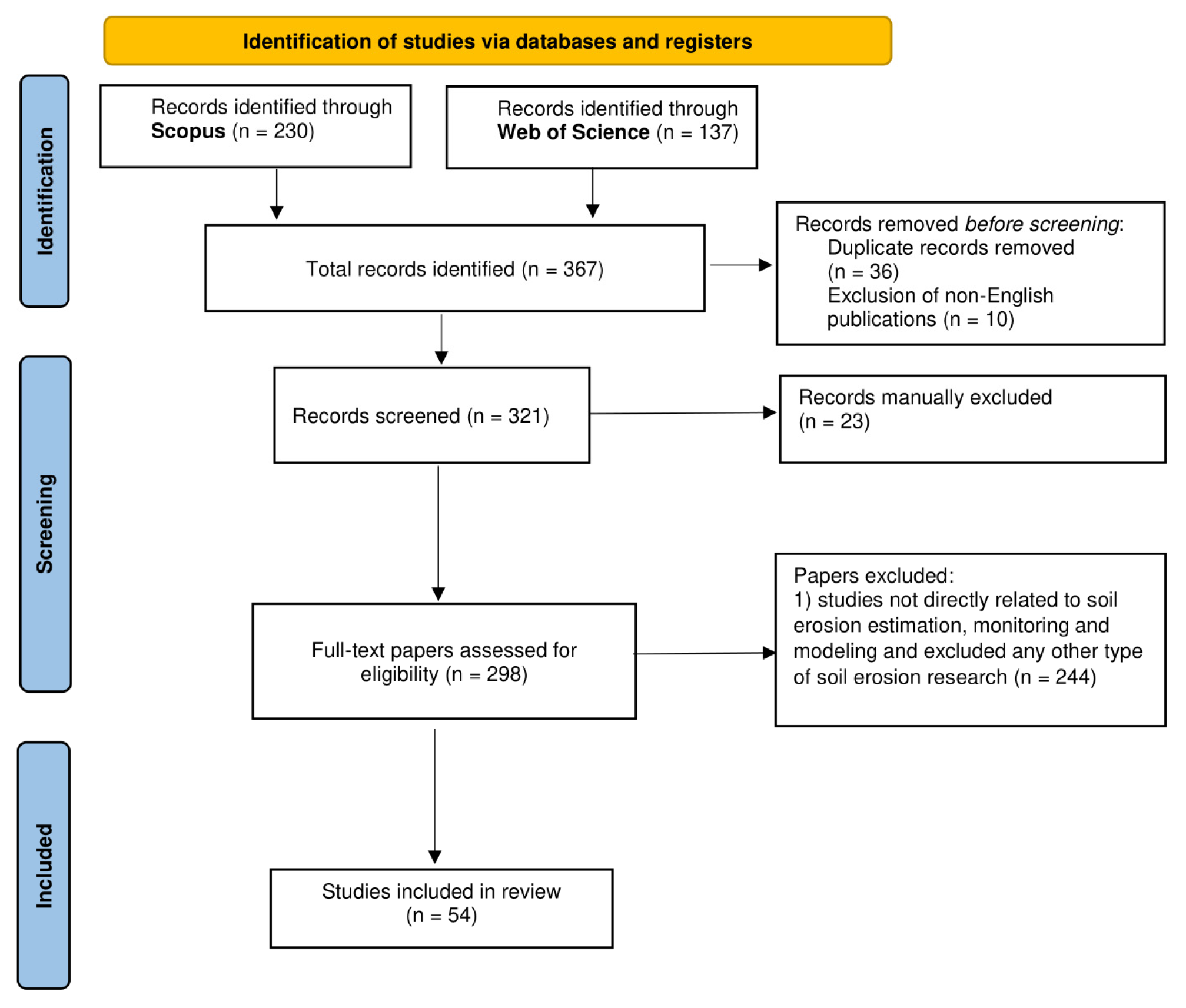
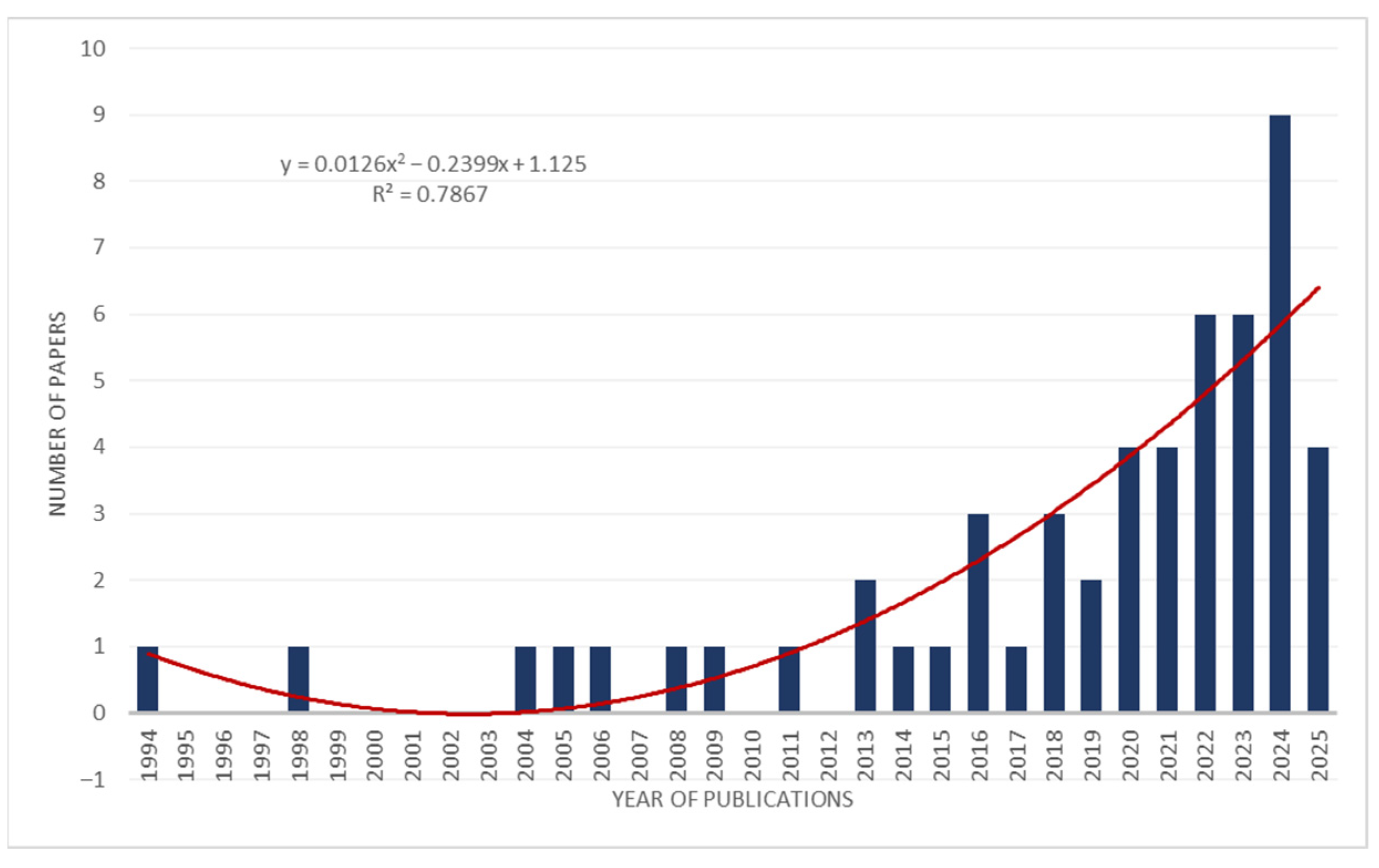
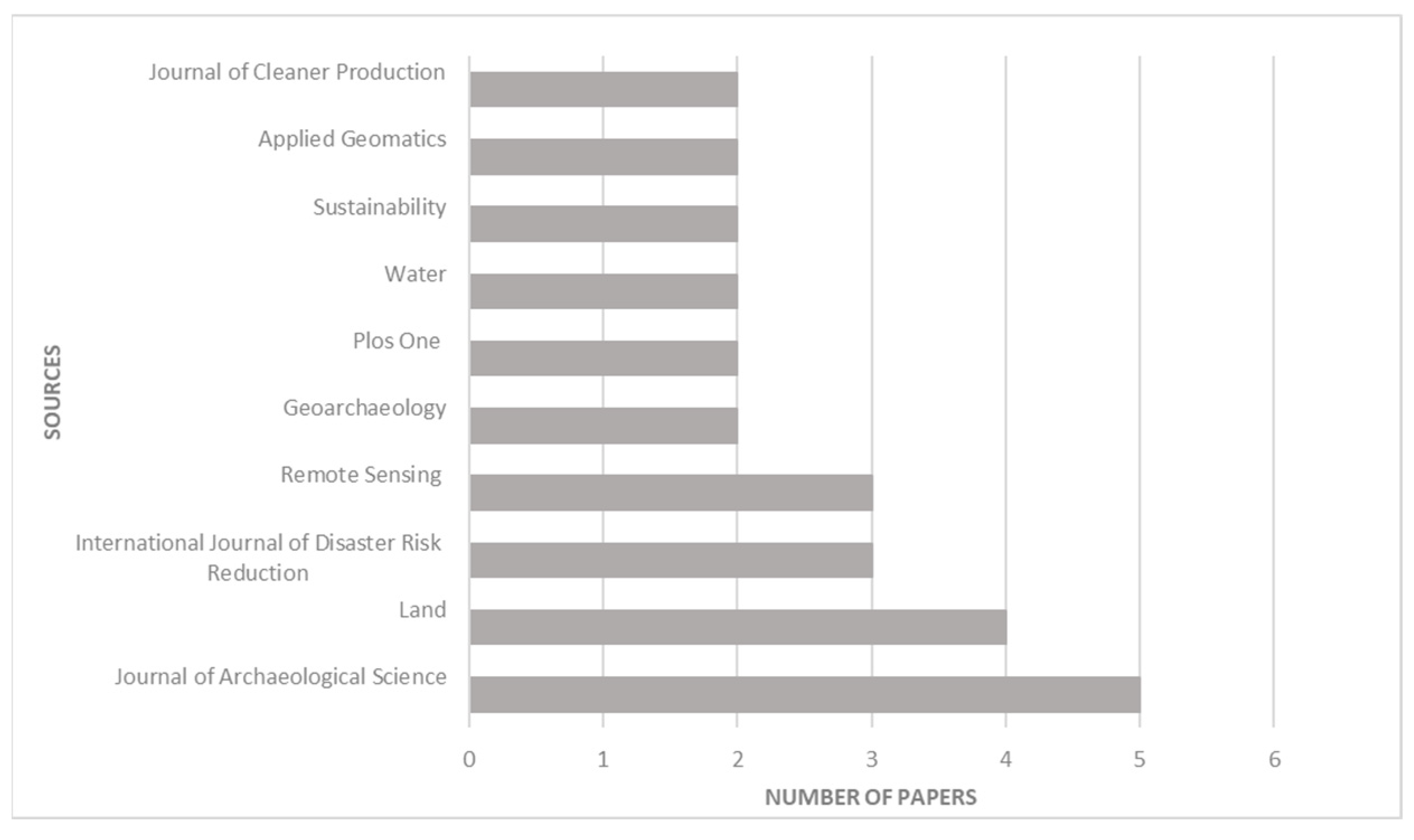
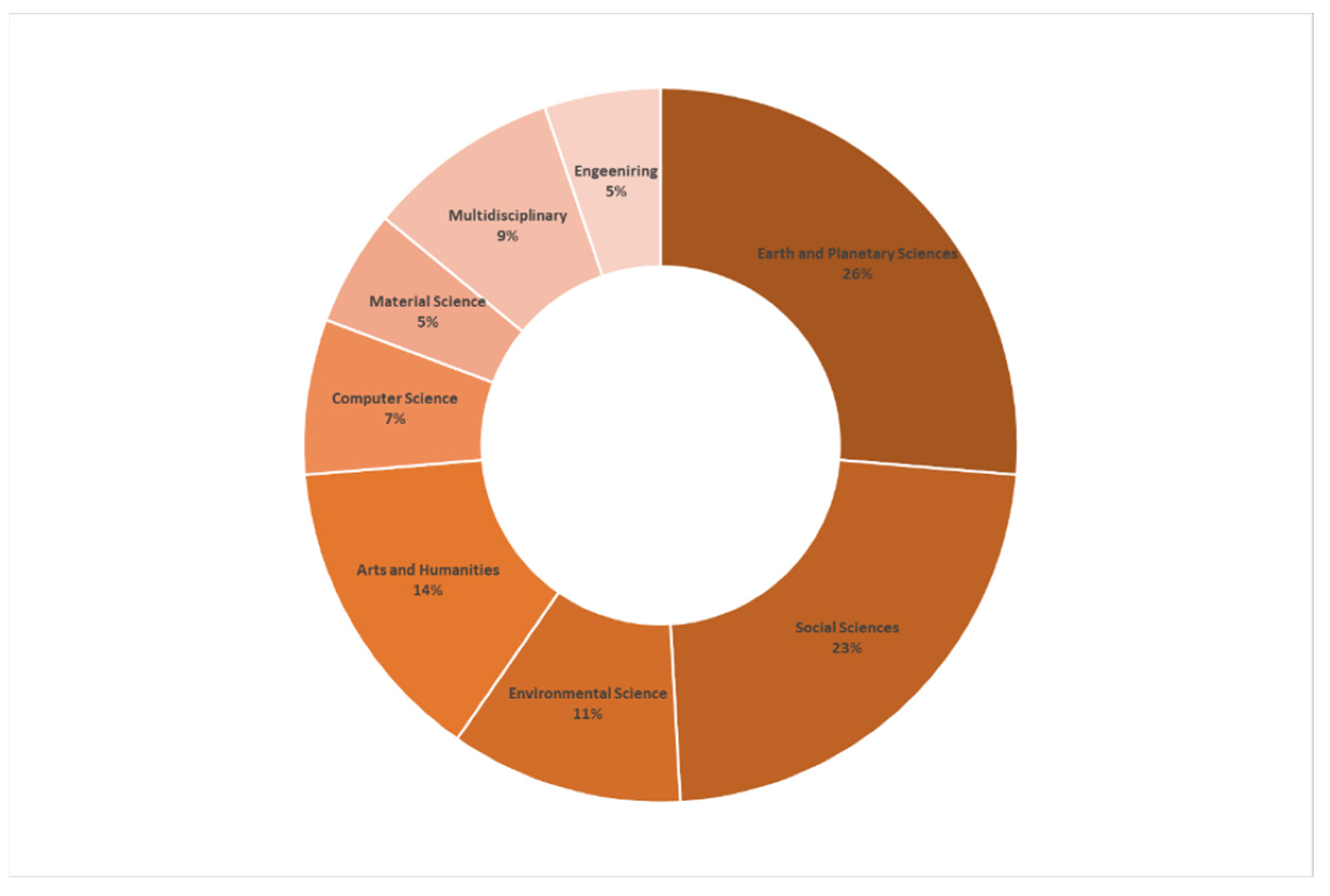

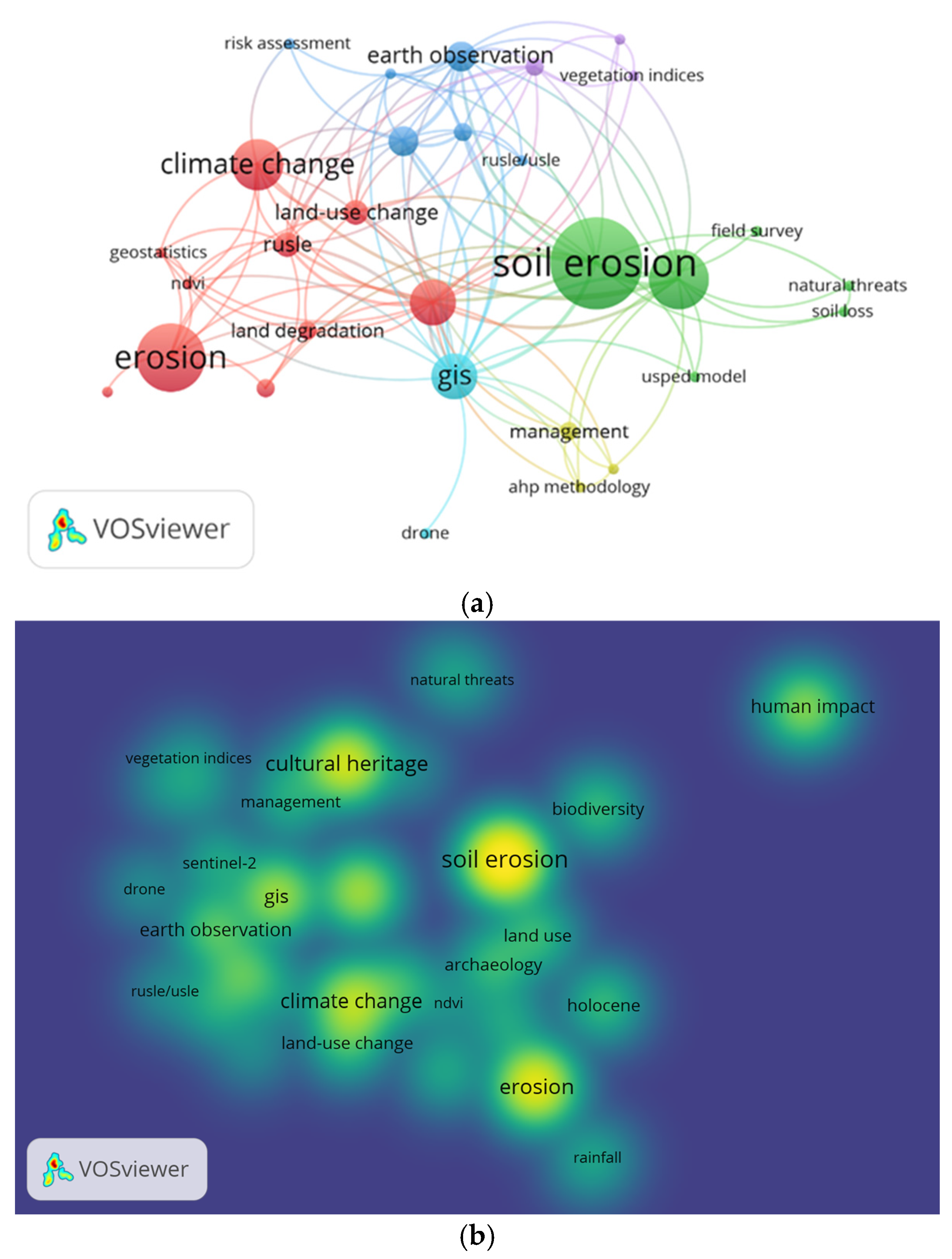
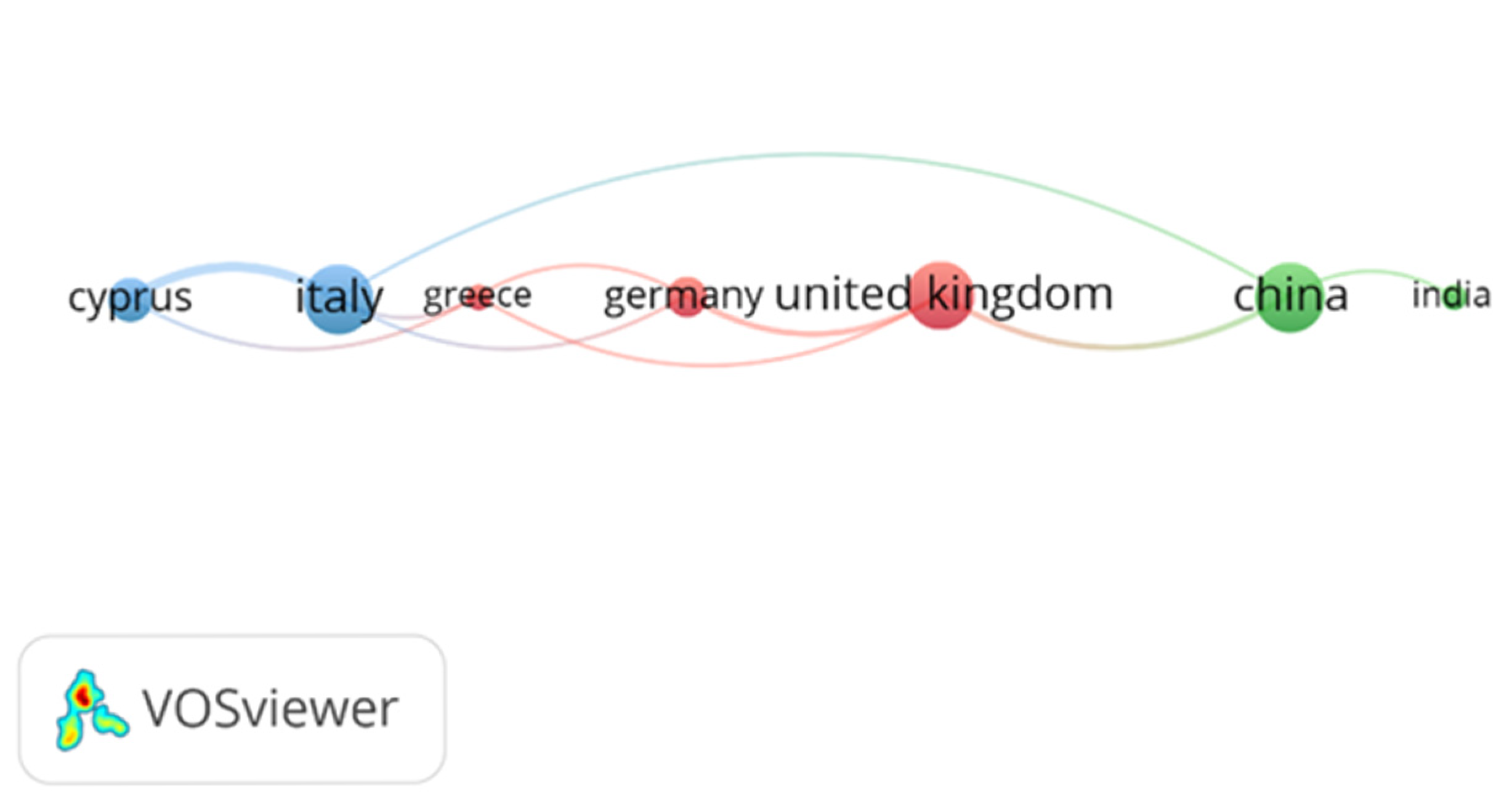
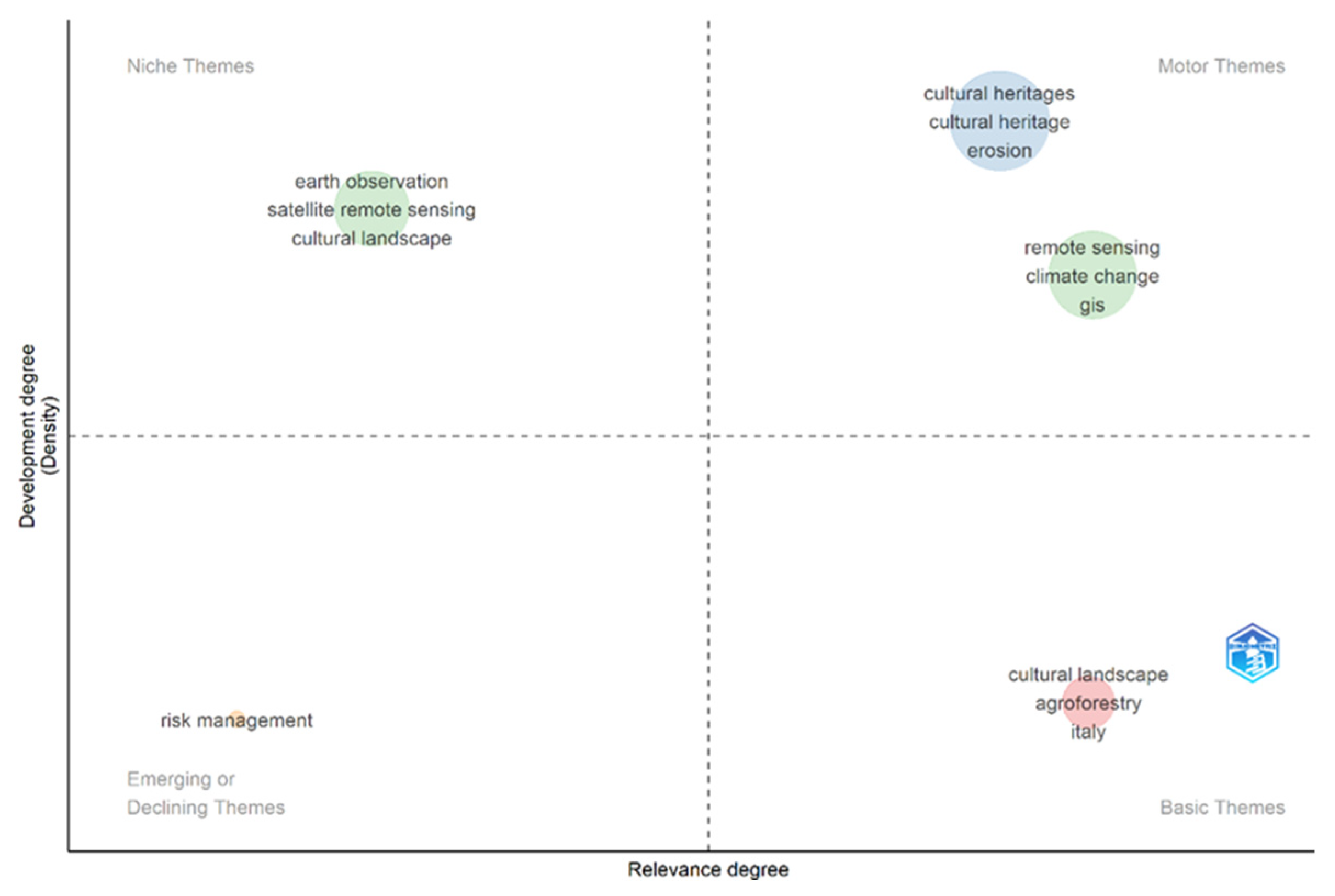
| Sensor(s) | Launch Year | Spatial Resolution | Temporal Resolution | Spectral Range (μm) | Number of Bands |
|---|---|---|---|---|---|
| Landsat-1 MSS | 1972 | 80 | 18 | 0.5–1.1 | 4 |
| Landsat 2 MSS | 1975 | 80 | 18 | 0.5–1.1 | 4 |
| Landsat 3 MSS | 1978 | 80 | 18 | 0.5–1.1 | 4 |
| Landsat 4 | 1982 | 30 | 16 | 0.45–2.35 | 7 |
| Landsat-5 TM | 1984 | 30, 120 | 16 | 0.45–2.35 | 7 |
| Landsat-7 ETM+ | 1999 | 15, 30, 60 | 16 | 0.45–12.5 | 8 |
| Landsat 8 OLI | 2013 | 15, 30 | 16 | 0.433–2.294 | 9 |
| Sentinel-2 MSI | 2015 | 10,20,60 | 5 | 0.443–2.202 | 13 |
| AVHRR | 1980 | 1100–5000 | 1 | 0.63–12 | 5 |
| IKONOS | 1999 | 4; 1 | 1.5–3 | 0.45–0.85 | 5 |
| Quickbird | 2001 | 0.6–2.6 | 2.4 | 450–900 | 5 |
| ASTER | 1999 | 15–90 | 16 | 0.52–2.43 | 15 |
| MODIS | 1999 | 250, 500, 1 km | 1–2 | 0.459–2.155 | 36 |
| Worldview 2 | 2009 | 0.5 | 1.1 | 450–800 | 9 |
| Geoeye 1 | 2008 | 0.5–1.8 | <3 | 450–920 | 5 |
| Indicator | Product | Spatial Resolution | Temporal Resolution | Data Availability |
|---|---|---|---|---|
| Rainfall | Tropical Rainfall Measuring Mission (TRMM) | 0.25° × 0.25° | 3 h | 1997–2015 |
| Climate Hazards group Infrared Precipitation (CHIRP) V2.0 | 0.05° × 0.05° | Daily/5-day/10-day/monthly | 1981–present | |
| Precipitation Estimation from Remotely Sensed Information using Artificial Neural Networks Cloud Classification System (PERSIANN-CCS) | 0.04° × 0.04° | 30 min | 2003–present | |
| Precipitation Estimation from Remotely Sensed Information using Artificial Neural Networks (PERSIANN) Climate Data Record (CDR) V1R1 | 0.07° × 0.07° | 6 h | 1983–2016 | |
| Remotely Sensed Information using Artificial Neural Networks (PERSIANN) | 0.04° × 0.04° | 1 h | 2000–present | |
| Global Precipitation Measurement (GPM) | 0.1° × 0.1° | 0.5–3 h | 2014–present | |
| Topography | Space Shuttle Radar Topography Mission (SRTM) | 30–90 m | 11 days | 2000–present |
| Advanced Spaceborne Thermal Emission and Reflection Radiometer Global Digital Elevation Model (ASTER GDEM) | 30 m | - | 2000–present | |
| Global Multi-resolution Terrain Elevation Data 2010 (GMTED 2010) | 30 m | - | 2010–present | |
| Global 30-Arc-Second Elevation Data Set (GTOPO30) | 1 km | - | 1996–present | |
| Vegetation Cover | MODIS MOD12Q1 | 500 m | 16 days | 2001–2018 |
| MODIS MOD12Q1 | 1 km | 16 days | 2001–2018 | |
| GlobLand30 | 30 m | - | 2000–2010 | |
| Esri’s 2020 Land Cover (Esri) | 10 m | - | 2020-present | |
| Google’s Dynamic World (DW) | 2020-present | |||
| ESA’s World Cover 2020 (WC) | 10 m | - | 2021-present | |
| Global Land Cover 2000 dataset | 100 m | - | 2000-present | |
| CLC1990 | ≤50 m | - | 1986–1998 | |
| CLC2000 | ≤25 m | - | 2000 +/− 1 year | |
| CLC2006 | ≤25 m | - | 2006 +/− 1 year | |
| CLC2012 | ≤25 m | - | 2012 +/− 1 year | |
| CLC2018 | ≤10 m (Sentinel-2) | - | 2018 +/− 1 year |
| Description | Records | ||
|---|---|---|---|
| Databases | WoS | Scopus | |
| Query terms | “soil erosion” AND “cultural heritage” OR “archaeological site” | 67 | 118 |
| “soil erosion” AND “cultural heritage” OR “archaeological site” AND “remote sensing” | 8 | 17 | |
| “soil erosion” AND “cultural heritage” OR “archaeological site” AND “satellite imagery” | 3 | 5 | |
| “soil erosion” AND “cultural heritage” OR “archaeological site” AND “SAR” OR “INSAR” | 1 | 4 | |
| “soil erosion” AND “cultural heritage OR archaeological site” AND “UAV” OR “Drone” | 3 | 4 | |
| “soil erosion” AND “cultural heritage” OR “archaeological site” AND “management” | 30 | 44 | |
| “soil erosion” AND “cultural heritage” OR “archaeological site” AND “assessment” | 20 | 26 | |
| “soil erosion” AND “cultural heritage” OR “archaeological site” AND “modelling” | 5 | 112 | |
| Time span | 1998–June 2025 Articles, book chapters, proceedings papers, reviews English | ||
| Document type | |||
| Language | |||
Disclaimer/Publisher’s Note: The statements, opinions and data contained in all publications are solely those of the individual author(s) and contributor(s) and not of MDPI and/or the editor(s). MDPI and/or the editor(s) disclaim responsibility for any injury to people or property resulting from any ideas, methods, instructions or products referred to in the content. |
© 2025 by the authors. Licensee MDPI, Basel, Switzerland. This article is an open access article distributed under the terms and conditions of the Creative Commons Attribution (CC BY) license (https://creativecommons.org/licenses/by/4.0/).
Share and Cite
Papageorgiou, N.; Hadjimitsis, D.; Danezis, C.; Lasaponara, R. Assessment of Soil Erosion Risk in Cultural Heritage Sites: A Bibliometric Analysis. Heritage 2025, 8, 307. https://doi.org/10.3390/heritage8080307
Papageorgiou N, Hadjimitsis D, Danezis C, Lasaponara R. Assessment of Soil Erosion Risk in Cultural Heritage Sites: A Bibliometric Analysis. Heritage. 2025; 8(8):307. https://doi.org/10.3390/heritage8080307
Chicago/Turabian StylePapageorgiou, Nikoletta, Diofantos Hadjimitsis, Chris Danezis, and Rosa Lasaponara. 2025. "Assessment of Soil Erosion Risk in Cultural Heritage Sites: A Bibliometric Analysis" Heritage 8, no. 8: 307. https://doi.org/10.3390/heritage8080307
APA StylePapageorgiou, N., Hadjimitsis, D., Danezis, C., & Lasaponara, R. (2025). Assessment of Soil Erosion Risk in Cultural Heritage Sites: A Bibliometric Analysis. Heritage, 8(8), 307. https://doi.org/10.3390/heritage8080307









